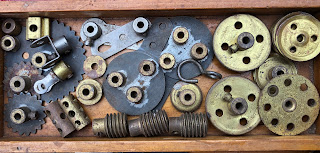Here is what I had after the first burst of building activity:

I came close to giving up at this point, because I could not for the life of me figure out how the steering column was meant to be supported. And also because I knew that I had prose like this to look forward to:
"The rear side panels of the passenger compartment are made from two 3-1/2" Strips, formed in their lower 1-1/2", two 2-1/2" Narrow Strips, and a 2-1/2" x 1-1/2" Plastic Plate, all held in place by 3/8" Bolts and four Washers spacing them from Obtuse Angle Brackets (slightly flattened) secured to the first and fourth holes of the 3-1/2" x 2-1/2" Flanged Plate."
But I persevered, and reached a point where all was done but for the passenger seat and motor. A good point for a photography break:




I made one improvement to the model as it came to me: the doors open!

Here is how I mounted the steering column. It passes through an elongated hole in the footboard and then through a 2-hole coupling bolted to a short axle rod, which is held in a 3-hole coupling to its right, which is bolted directly to the footboard. By rotating and sliding this short rod in its coupling, the 15-tooth gear's orientation and pressure on the contrate gear can be adjusted at will (up to the limits imposed by the elongated hole's size):

The remaining problem with this arrangement is that the 15-tooth gear can "wander" and climb off the contrate if enough steering pressure is applied. I don't know how to fix that without major changes. Using a simple coupling where the orthogonal axles meet to hold them in place won't work because the small contrate doesn't allow enough room for one; but there's no room for a large contrate in this design. I decided to let it be and rely on the driver not to apply superhuman force to the steering wheel.











